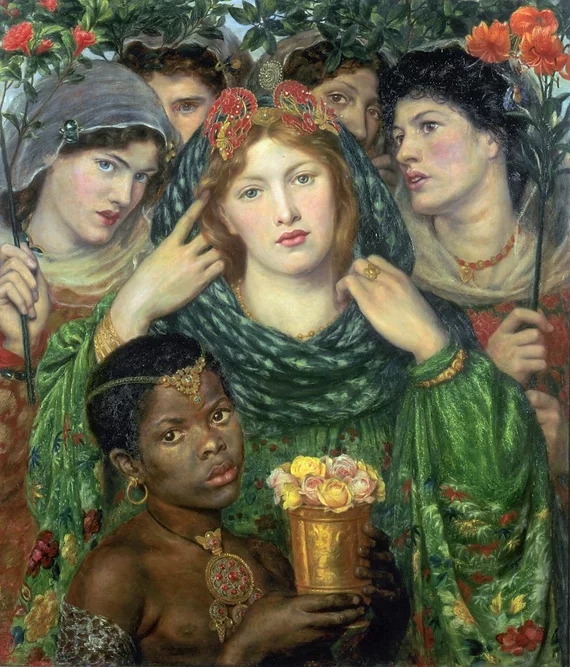The Shulammite: “Black and Beautiful” or “Black but Beautiful”?
The biblical book Song of Songs is mostly unfamiliar to Christians because they do not read it very often. When they do, they wrongly call it “The Song of Solomon” believing that Solomon wrote this beautiful song. In Hebrew, the title of the book is a superlative. The book should be translated “The Song of All Songs” or “The Greatest Song.”
Many Christians follow Jewish tradition by ascribing the authorship of the Song of Songs to Solomon. In fact, a Jewish saying declares that when Solomon was young he wrote Proverbs, when he was in love he wrote Song of Songs, and when he was old he wrote Ecclesiastes. None of these, of course, is true, but it serves to continue the idea that Solomon was the writer of these three biblical books.
As for the canonicity of Song of Songs, the book had some problems in being accepted as part of the canon. The reason for this reluctance is because Song of Songs tells a story of love with graphic sexual language. Most people reading Song of Songs in English will not notice the sexual language because the writer used euphemisms to hide the sexuality of the dialogue between the woman and her lover.
Eventually, the book was accepted as canonical because it was interpreted allegorically. Under this interpretation, Song of Songs describes the love of God for Israel or the love of Christ for the church. However, when properly understood, Song of Songs is a love story. The book describes in poetic form the love between a man and a woman.
Over the centuries, most readers of the book have struggled with the proper interpretation of this story of love. The traditional interpretation says that the book tells the story of two lovers: Solomon and the Shulammite. For the proper interpretation of the story, it is important not to confuse the Shulammite (Songs 6:13) with Abishag the Shunammite of 1 Kings 1:3-4. They were two different persons.
Under the traditional interpretation of the Songs, the book is telling the readers the story of Solomon’s love for the Shulammite. The traditional interpretation also implies that Solomon wrote Song of Songs in order to express his love for the Shulammite.
There is, however, a problem with the traditional interpretation. If the lover whom the woman loved was Solomon, then the reader must also assume that Solomon was a shepherd who took care of his flock. For this reason, it is very clear that Solomon was not the man the Shulammite loved.
A better interpretation of the Songs sees three lovers in the story: Solomon, the Shulammite, and the one she loved, the shepherd. Under this interpretation, Songs is a story about Solomon and not a story by Solomon.
This interpretation understands Song of Songs as a satire on Solomon. The story celebrates the victory of true love and tells of the occasion when Solomon’s desire to have another woman as a member of his harem was foiled by a peasant woman who refused to exchange the man she loved for the comfort of the palace.
Here was a man who already had “sixty queens and eighty concubines, and maidens without number” (Songs 6:8-9), but who wanted one more. But Solomon’s display of riches and might (Songs 3:6-11; 8:11) to gain the love of a peasant woman did not succeed. Solomon’s wealth and royal position could not convince the woman to accept the king’s advance and deny her love for the shepherd.
Song of Songs celebrates true love between a man and a woman, the kind of love that cannot be bought with money: “Many waters cannot quench love, neither can floods drown it. If a man offered for love all the wealth of his house, he would be utterly despised” (Songs 8:7).
Who was this remarkable woman, the Shulammite, who refused the wealth of Solomon and the enticement of royalty in order to remain true to her shepherd lover? The Bible has little to say about her. However, it is what she said about herself that has attracted the attention of many scholars.
She said about herself: שְׁחוֹרָ֤ה אֲנִי֙ וְֽנָאוָ֔ה
English translations differ on the interpretation of her words:
The New Revised Standard Version: “I am black and beautiful.”
The Douay-Rheims Bible: “I am black but beautiful.”
The English Standard Version: “I am very dark, but lovely.”
The Jewish Publication Society: “I am black, but comely.”
The Septuagint (LXX): “I am black, but beautiful.”
The Shulammite words are addressed to the women of Jerusalem. Although the women do not respond, it is apparent that the women are looking at the Shulammite with disdain because of her appearance. She refers to her color and compares it with the tents of Kedar and the curtains of Solomon.
“I am very dark, but comely, O daughters of Jerusalem, like the tents of Kedar, like the curtains of Solomon” (Songs 1:5 RSV).
She said that she had a dark complexion because she was exposed to the hot sun, since her brothers punished her by ordering her to take care of the vineyards:
“Do not gaze at me because I am swarthy, because the sun has scorched me. My mother’s sons were angry with me, they made me keeper of the vineyards; but, my own vineyard I have not kept” (Songs 1:6 RSV).
The text does not say that her dark complexion was due to her racial background, that is, that she was an African woman. Her dark skin pigmentation was not a reference to a racial feature. The Shulammite was not a white woman nor an African woman. The Shulammite was a Semitic woman.
What the Shulammite was trying to say to the women of Jerusalem was that the exposure to the sun on her body made her to be darker than the women who lived in Jerusalem. She was dark because she did not protect her body from the intense heat of the sun.
The Shulammite’s words reflect the fact that peasant women who worked in the fields had dark skin because of the constant exposure to the sun, while the women who lived in luxurious houses of Jerusalem and those who lived in the palace were less dark and more white.
The woman explained her blackness by comparing it with the tents of Kedar and the curtains of Solomon. The tents of Kedar were bedouin tents made of black goat hair. Although the text does not clarify what was intended by “the curtains of Solomon,” they were probably curtains or wall hangings found in Solomon’s palace known by its beauty and artistic designs.
The reading of the Holman Christian Standard Bible tries to include both ideas in its translation, but in the process it diminishes what the Shulammite says about herself: “Daughters of Jerusalem, I am dark like the tents of Kedar, yet lovely like the curtains of Solomon.”
The reason for the punishment her brothers inflicted on her was because she did not keep her own vineyard. The symbolism behind the vineyard is probably a reference to her virginity, that is, that she gave herself sexually to her shepherd lover and as a result her brothers punished her for her indiscretion.
Thus, the Shulammite asked the women of Jerusalem not to pay attention to her black skin. In Hebrew the conjunction waw can be translated as “and” or “but.” Many people object to translating the Shulammite words as “black but beautiful” because such a translation may suggest that blackness is not beautiful. Critics complain that this translation may point to some kind of racial prejudice.
A careful look at the text reveals that the woman was explaining that although she had a dark complexion that she was beautiful. The reason she spoke about her dark skin was probably because it had become an issue in the minds of people who belonged to the upper class of Jerusalem.
So the questions must be asked: should we translate the waw as “and” or “but”?
A careful examination of the Shulammite words in light of her conversation with the women of Jerusalem reveals that the woman was defending her dark skin. In addition, verse 6 explains that her skin was dark because her brothers forced her to work in the vineyards and she was exposed to the hot sun. This is the reason she asks the women of Jerusalem not to look at her and her dark complexion with disdain.
The text has nothing to do with race, neither is the text saying that white skin is more attractive than dark skin. The problem is that today’s society classifies people as either black, white, or brown. Since this woman was a Semitic woman, she probably had dark skin. She was not white. The Shulammite defended her dark skin not because she believed that it was ugly, but because her natural skin was not like that.
Thus, readers must conclude that the woman was unhappy about her dark skin because it was not her natural skin color but it was the result of being exposed to the sun for a long time. The proper translation of 1:5 should be: “I am black but beautiful.”
However, when we read the words of the Shulammite, we can say with assurance, that she was black and beautiful, for the woman herself speaks unashamedly about her beauty: “I am both black and beautiful.”
Claude Mariottini
Emeritus Professor of Old Testament
Northern Baptist Seminary
NOTE: Did you like this post? Do you think other people would like to read this post? Be sure to share this post on Facebook and share a link on Twitter or Tumblr so that others may enjoy reading it too!
I would love to hear from you! Let me know what you thought of this post by leaving a comment below. Be sure to like my page on Facebook, follow me on Twitter, follow me on Tumblr, Facebook, and subscribe to my blog to receive each post by email.
If you are looking for other series of studies on the Old Testament, visit the Archive section and you will find many studies that deal with a variety of topics.





